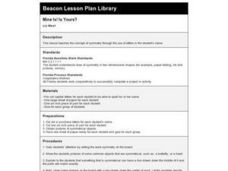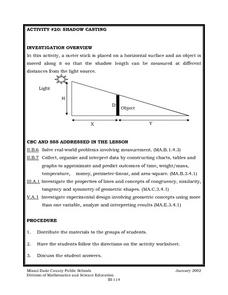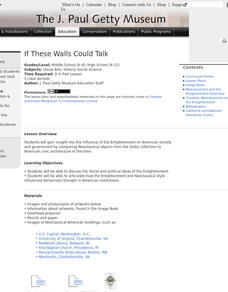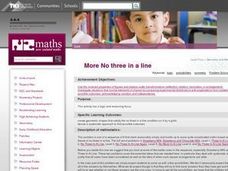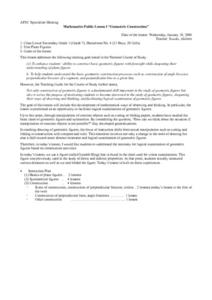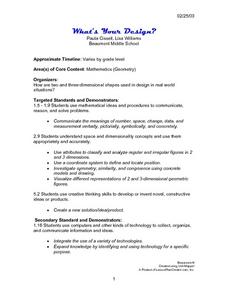Curated OER
Logo Licenses
Third graders find all the lines of reflection symmetry in a given shape, identify the order of rotational symmetry of a given shape. They create designs which have reflection symmetry, rotational symmetry (orders 2, 3, 4, 6) and...
Curated OER
Symmetrical Journals
Students examine the concept of symmetry by studying the symmetry of symbols in a wall painting and creating journals with a symmetrical design. After a class review of symmetry and identifying the line of symmetry in several objects in...
Curated OER
Mine Is! Is Yours?
First graders engage in a lesson which teaches the concept of symmetry through the use of letters in the student's name. They use a piece of yarn to see if they can make symmetrical pieces out of their own names.
Curated OER
Transformation
In this transformation worksheet, learners identify and solve 10 different problems that include various images. First, they determine whether each object illustrated is a mirror image or reflection of the other image in the problem....
Curated OER
Reflections
Students investigate the concept of reflectons. They investigate how an image has a reflection that is symmetrical. They also choose household objects in order to have real life application for finding lines of symmetry.
Curated OER
Worksheet 12
In this math worksheet, students explain the vector parametric equation for a line, scalar parametric equations, symmetric equations, and the implicit equation for a line.
Curated OER
Halves
Is it half? There are three sections to this introductory fractions learning exercise focusing on halves. First graders begin by coloring half of five basic shapes, each of which already is divided into two parts. Next, they examine four...
Curated OER
Shadow Casting
Eighth graders use a meter stick that is placed on a horizontal surface and an object is moved along it so that the shadow length can be measured at different distances from the light source. They solve real-world problems involving...
Texteam Geometry Institute
Geometry for the High School Classroom
What does it mean for apples to have chirality? This and other explorations in geometry, such as tiling the plane, boxing a tetrahedron, and investigating Euclid's Characteristic, are included in this resource on Euclidean geometry....
Curated OER
Two Halves Make a Whole
In this whole and parts instructional activity, students study the shapes that each have a line of symmetry. Students draw the missing half so that each half is the same. Students then write if a diamond has more than 1 line of symmetry.
Ohio Department of Education
I Can Name that Angle in One Measure! - Grade Eight
Collaborative groups work with geometry manipulatives to investigate conjectures about angles. They create a graphic organizer to use in summarizing relationships among angles in intersecting, perpendicular and parallel lines cut by a...
Curated OER
Quilt Squared
Students study West Virginia quilts. In this mathematics instructional activity, students use symmetry, geometric shapes, and patterns to create their own quilt square.
Curated OER
If These Walls Could Talk
Students compare Neoclassical objects from the Getty collection to American civic architecture of the time. They discuss the moral and political ideas of the Enlightenment and articulate how these art forms influenced democratic thought...
Curated OER
More No-Three-In-A-Line
Fourth graders read Mary's problem and make sure that they examine it.
After some discussion, let the class work on the problem in their groups.
They then take turns in putting a picture of their arrangement on the board.
EngageNY
Construct and Apply a Sequence of Rigid Motions
Breaking the rules is one thing, proving it is another! Learners expand on their previous understanding of congruence and apply a mathematical definition to transformations. They perform and identify a sequence of transformations and use...
Curated OER
Geometry in Tessellations
Students examine tessellations and their geometric properties. Students explore the concept of tessellations and lines, planes, angles, and polygons. Students experiment with the area and perimeter of polygons. Students analyze...
Curated OER
Introduction to Fractals: Infinity, Self-Similarity and Recursion
Students think about several of the concepts from fractals, including recursion and self similarity. They use mathematical concepts of line segments, perimeter, area and infinity are used, and skill at pattern recognition is practiced.
Curated OER
Translations, Reflections, and Rotations
Students are introduced to the concepts of translation, reflection, and rotation. They practice translating, reflecting, and rotating two-dimensional objects on the coordinate plane. students use computers to learn about the three concepts.
Curated OER
Terrific Tessellations
Students explore tessellations that are found in nature and everyday objects. They observe the works of M.C. Escher. Students create their own tessellations using pencil and paper.
Curated OER
Geometric Construction
Seventh graders investigate some concepts associated with geometric shapes. They study the bisector segment and the perpendicular line to a given line. Students conduct analysis with the goal of deepening observation and deduction...
Curated OER
Compound Locus
Students investigate circles and compound locus. In this geometry instructional activity, students identify the distance from a point to a line. They use Cabri software to create lines and circles.
Curated OER
Camping with a Triangular Prism and Its Net
Students differentiate triangular prisms from other prisms using nets. In this geometry instructional activity, students define the properties of a triangular prism and its symmetry. They build a triangular prism moving lines around.
Curated OER
What's Your Design?
Sixth grade students: design a stained glass window, submitting their initial plan detailing the measurements of all lines and angles. Seventh grade students: create a scale drawing of their own geometric family of four members.
Curated OER
Comparing and Contrasting
Students practice compare and contrast skills. For this science and language development lesson, students complete a T chart generating traits of a snail and a clam. Students complete a related worksheet.




